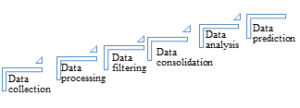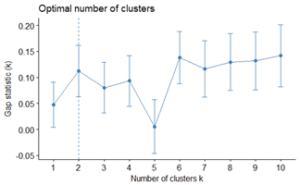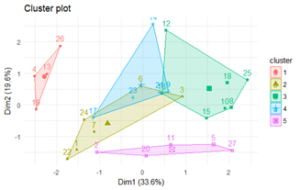Melnykova Nataliia
Abstract
The study was conducted on the applying of machine learning methods to search for key clusters, which made it possible to investigate individual patient characteristics, and to determine distances between cluster instances. It was suggested to determine the average distance between instances in order to find optimal performance metrics. That will determine the optimal state of the instance of this cluster.
Keywords: personalization, decision-making, medical data, artificial intelligence, Data Mining, Machine Learning
Introduction
In today’s world of innovation, the issue of applying modern, artificial intelligence based solutions to optimize processes in various fields of human activity is being actively considered. Medicine is no exception, and is even a key area of application of new trends in the processes of diagnostics, drug development, personalized treatment and gene editing. Years are required of medical training to properly diagnose the disease. The diagnosis is often a difficult, time-consuming process. In many areas, the demand for experts far exceeds the available supply. This puts a strain on doctors and often delays vital patient screening processes. Especially deep learning algorithms have made great progress in the automatic diagnosis of diseases recently that have made diagnostics cheaper and more affordable. Consolidation of heterogeneous data in the assessment of disease or its progression is the using of machine learning in diagnostics, namely the results of computed tomography (CT), magnetic resonance imaging (MRI), genomics, individual patient data and handwritten files. Artificial intelligence can automate a great deal of manual work and speed up the process of medical care [1,6,7,10].
Although, artificial intelligence is unlikely to replace doctors at once. However, innovative and intelligent systems will be used to show potentially risky signs for the expert, which will allow the doctor to focus on received data the findings to make key treatment or rehabilitation decisions. Using artificial intelligence (AI) algorithms to classify data, identify key parameters, predict positive or negative decisions about diagnosis or treatment, helps doctors focus on analysing the best prospects when providing quality care to their patients [1,8,9].
Materials and Methods
Existing solution
Developers from major companies, including Microsoft, Apple, Google, and IBM, are working to create products using artificial intelligence for health care agencies. According to analysts, such firms are already 800 in the world. Despite the fact that innovative technologies have only just begun to be introduced into the medical field, according to Frost & Sullivan’s study, this market will grow to $ 6.16 billion at a compound annual growth rate (CAGR) of 68.55% between 2018 and 2022 [2,15].
For example, a complete medical history, analysis data for all years of treatment, the current state of the body – all this can be collected and structured by the artificial intelligence system. Data uploaded to the database will not elude the brain and will be processed quickly. This will save doctors time, increase the accuracy of diagnosis and allow timely appoint the necessary treatment [2,6,19].
This is how a system from IBM that called Watson Health works. It is able to identify potential problems with the vascular system, recognize cancer and determine whether a patient is prone to blood clots. IBM Watson can respond promptly when it comes to learning new information and drawing conclusions from it. For example, IBM’s artificial intelligence has analysed 20 million oncology scientific articles in 10 minutes and based on that, the patient was correctly diagnosed [3,4].
In several hospitals in the UK, a similar development from Google – DeepMind Health is already in use. It also helps to process all human health information and shares its findings with the attending doctor that determines the final diagnosis. [3,17,22,24].
The systems like Ada can communicate directly with a person and give him or her recommendations. This is a service, which is developed by a British company of the same name. The medical application communicates with the patient, inquiries about symptoms and complaints, and in response gives recommendations, including – which doctor to visit or suggests to contact a specialist for remote consultation [4,9,17].
The AI Sense program monitors the status of people who have recently undergone long-term treatment or who suffer from chronic illness. It was developed by a startup from San Francisco and raised 8 million venture capital investments in the initial phase. The application is designed to structure human condition data, send it to a specialist, and make recommendations. The system is also capable of reminding you of your medication time and the need to visit your doctor [5,12,22].
Genetic analysis systems are similarly functioning that help to understand the primary cause of the disease. One of the human genome verification platforms – Sophia Genetics – reveals a patient’s predisposition to various diseases and draws the doctor’s attention [6,7,11].
On a similar principle, the selection of medication for a particular patient is carried out and the analysis of the effect of drugs on the body. For example, the MedClueRx system is designed for to determine which drugs are better suited for nervous disorders, diseases of the gastrointestinal tract, epilepsy y [7,9,14].
The problem of personalization of decisions
According to the results of the analysis of existing AI systems in the field of medicine for solving problems of disease diagnostics, genome research, drug development, medical imaging, etc. it is possible to single out problems that still remain unresolved. This is a study of the problem of patient data consolidation, its individual characteristics, taking into account international standards of treatment and existing pharmaceutical products, which will allow to define personalized treatment and to predict the results of its use [15,17,21,23].
Different patients respond to medicines and treatment regimens differently, so personalized treatment has huge potential to increase patients’ life expectancy. However, it is very difficult to determine what factors should influence the choice of treatment. AI algorithms can automate complex statistical work and help identify which characteristics indicate that the patient will have some positive reaction to a particular treatment or vice versa. Therefore, the algorithms may predict the patient’s likely response to a particular treatment [13,16,19,22].
The research results of medical data analysis
Changes in the delivery of quality care require innovative tools to manage patient information and decision-making. In the context of such tasks, a prerequisite for the time being is to improve the methods and algorithms of artificial intelligence, which will improve the processes of diagnosis, treatment, and provision of medical care. According to world forecasts, the using of artificial intelligence in healthcare could improve medical care outcomes by 30-40 percent, reducing treatment costs by 50 percent. [1,8,10,11]
Necessary the using steps for collecting, processing, filtering, consolidating analysis, and predicting heterogeneous patient data are required to find effective solutions of identify semantic relationships between key characteristics and to seek personalized diagnosis or treatment. (Fig.1) This will allow for an objective assessment of the data and the formation of major patient clusters to event development simulation and forecast situations in decision support systems. However, the use of Machine Learning and Data Mining techniques will allow us to identify key trends in patient states estimate based on the information obtained.

Fig.1. The dependency of patient medical data in research stages for their intellectualization on personalized decision-making.
According to the results of research, taking into account the parameters of 50 patients during hospitalization, can distinguish the optimal number of clusters. Taking into account the key patients’ parameters namely time-dependent and time-independent parameters of patients, given which allowed to distinguish by gap method (gap-statistics) 5 main clusters. (Fig 2)

Fig.2 The applying the gap-statistics method to find the optimal number of clusters.
In order to describe the relationships between them, it is advisable to analyse the criterion of divergence between patients. To do this, we enter the measure of distance Li. The distance not from one point – the etalon, but the distance from the point aij (object presented for recognition) to all points of the set belonging to a given class is estimated.
The attributes can have different ranges of represented entities in the selection, the distance can be very dependent on attributes with large ranges. Therefore, data are almost always normalized. This will normalize the values of patients with heterogeneity. To reconcile the data by calculating the average divided by the standard deviation, namely a biochemical blood, temperature data or bacteriological laboratory tests, etc.
Major clusters of elements for 1000,000 operations by k-means method were analysed. (Fig.3)

Fig.3 The applying the k-means method to determine the distribution of elements between clusters.
Automation of data collection in hospitals will make the purpose of therapeutic treatment more accurate, will be able to effectively predict and prevent diseases. In this way, artificial intelligence will not only facilitate the work of doctors, but also help save more patients [9,24].
Conclusions
The research has been conducted on the application of machine learning methods to the search for key clusters, taking into account the individual characteristics of patients, determining the distances between cluster instances.
Determining the average distance between instances to find the best performance metrics has suggested. That will determine the optimal state of the instance of this cluster.
The process of processing medical data for finding personalized solutions in accordance with applicable norms and standards has been formalized.
So, the using the methods of computational intelligence, it is proposed to classify persons by state, to determine the deviation of the parameters from the normal parameters of the group, as well as the average parameters of that person. This allowed for a personalized approach to monitoring the condition and making recommendations for each patient, based on long-term follow-up and doctor-led monitoring.
According to the results of the analysis, the possible to predict the optimal general condition for a particular person becomes, which will help to improve life satisfaction and ensure its extension.
References
- Technology Research Reinvented/ https://www.venturescanner. com/page/91/
- Kayla Belcher, From $600 M to $6 Billion, Artificial Intelligence Systems Poised for Dramatic Market Expansion in Healthcare, Frost & Sullivan, 2020, https://ww2.frost.com/news/press-releases/600-m-6-billion-artificial-intelligence-systems-poised-dramatic-market-expansion-healthcare/
- Expanding our knowledge, finding new answers/ https://deepmind.com/about.
- Manage your health with Ada / https://ada.com/.
- Next Generation Solutions for Patient Engagement / https://www.sensely.com/
- Democratizing Data-Driven Medicine / https://www.sophiage-netics.com/home.html
- Oleksii Kharkovyna/ Artificial Intelligence & Deep Learning for Medical Diagnosis/ https://towardsdatascience.com/artificial-intelligence-deep-learning-for-medical-diagnosis-9561f7a4e5f.
- Mulesa P., Perova I. Fuzzy Spacial Extrapolation Method Using Manhattan Metrics for Tasks of Medical Data Mining Computer Science and Information Technologies CSIT’2015. – Lviv, Ukraine. – 2015, р. 104-106.
- Melnykova, N., Marikutsa, U., & Kryvenchuk, U. (2018). The new approaches of heterogeneous data consolidation. In 2018 IEEE 13th International Scientific and Technical Conference on Computer Sciences and Information Technologies, CSIT 2018 – Proceedings (Vol. 1, pp. 408–411). Institute of Electrical and Electronics Engineers Inc. https://doi.org/10.1109/STC-CSIT.2018.8526677
- Perova, I. Pliss, G. Churyumov, Franklin M. Eze, Samer Mohamed Kanaan Mahmoud Neo-Fuzzy Approach for Medical Diagnostics Tasks in Online-Mode // 2016 IEEE First International Conference on Data Stream Mining & Processing (DSMP). – Lviv, Ukraine. – 2016, p. 34-38.
- Melnykova, N. The personalized approach in a medical decentralized diagnostic and treatment / Melnykova, N., Shakhovska, N., Sviridova, T.// 14th International Conference The Experience of Designing and Application of CAD Systems in Microelectronics, CADSM 2017. P. – 295-297.
- Melnykova, N. Semantic search personalized data as special method of processing medical information / Melnykova, N. //Advances in Intelligent Systems and Computing. 2017. P. – 315-325
- Bodyanskiy, I. Perova, O. Vynokurova, I. Izonin “Adaptive Wavelet Diagnostic Neuro-Fuzzy System for Biomedical Tasks” Proc. of 14th International Conference on Advanced Trends in Radioelectronics, Telecommunications and Computer Engineering (TCSET), Lviv-Slavske, Ukraine, February 20 – 24,
- Izonin, I. The combined use of the wiener polynomial and SVM for material classification task in medical implants production / Izonin, I., Trostianchyn, A., Duriagina, Z., (…), Tepla, T., Lotoshynska, N. // International Journal of Intelligent Systems and Applications. 2018, 9, P. – 40-47
- Boyko, N., Use of machine learning in the forecast of clinical consequences of cancer diseases / Boyko, N., Sviridova, T., Shakhovska, N.// 7th Mediterranean Conference on Embedded Computing, MECO 2018 – Including ECYPS 2018, Proceedings . Budva, 2018, pp. 1-6.
- Calvaneseand D. Calvanese, G. De Giacomo, D. Lembo, M. Lenzerini, A. Poggi, and R. Rosati,“Ontology-based database access”in Proc. of SEBD–2007. 2007. pp. 324–331.
- Mintser and O. Stryzhak1, S. Denysenko, “Use of principles of medical ontology for construction of scenario models of post-graduate education of doctors and pharmacists,” in National Medical Academy of Postgraduate Education. Shupyk, Medical Informatics and Engineering, – Kyiv, 2013, No 2,.pp. 18-23.
- Slyunyayev, “Methods of finding solutions in intelligent multi-agent information management system airport” in Proceedings of the Military Institute of Kyiv National University. Taras Shevchenko. №28.2010. – K: 2010. – pp. 110-114.
- Dunham, “Data Mining Introductory and Advanced Topics” in Pearson Education. — Inc., 2003.
- Donald Knuth, “Generating all trees. The history of combinatorial generation” in The Art of Computer Programming. – M.: “Williams”, 2007. – T. 4. – P. 160.
- Perova, O. Litovchenko, Ye. Bodyanskiy, Ye. Brazhnykova, I. Zavgorodnii, P. Mulesa. Medical Data-Stream Mining in the Area of Electromagnetic Radiation and Low Temperature Influence on Biological Objects // Proc. 2018 IEEE Second International Conference on Data Stream Mining & Processing (DSMP), August 21-25, 2018, Lviv, Ukraine, pp. 3-6
- Perova, Ye. Bodyanskiy, Ye. Brazhnykova, P. Mulesa Neural Network for Online Principal Component Analysis in Medical Data Mining Tasks IEEE First International Conference on System Analysis & Intelligent Computing (SAIC) 8-12 October 2018, Kyiv, Ukraine, pp.150-154
- Perova, Ye. Bodyanskiy Fast medical diagnostics using autoassociative neuro-fuzzy memory // International Journal of Computing, 16 (1), 2017, 34-40.
- Melnykova, N., Vasilevskis, E., & Melnykov, V. (2018). The personalized approach to the processing and analysis of patients’ medical data. In CEUR Workshop Proceedings (Vol. 2255, pp. 103–112). CEUR-WS

